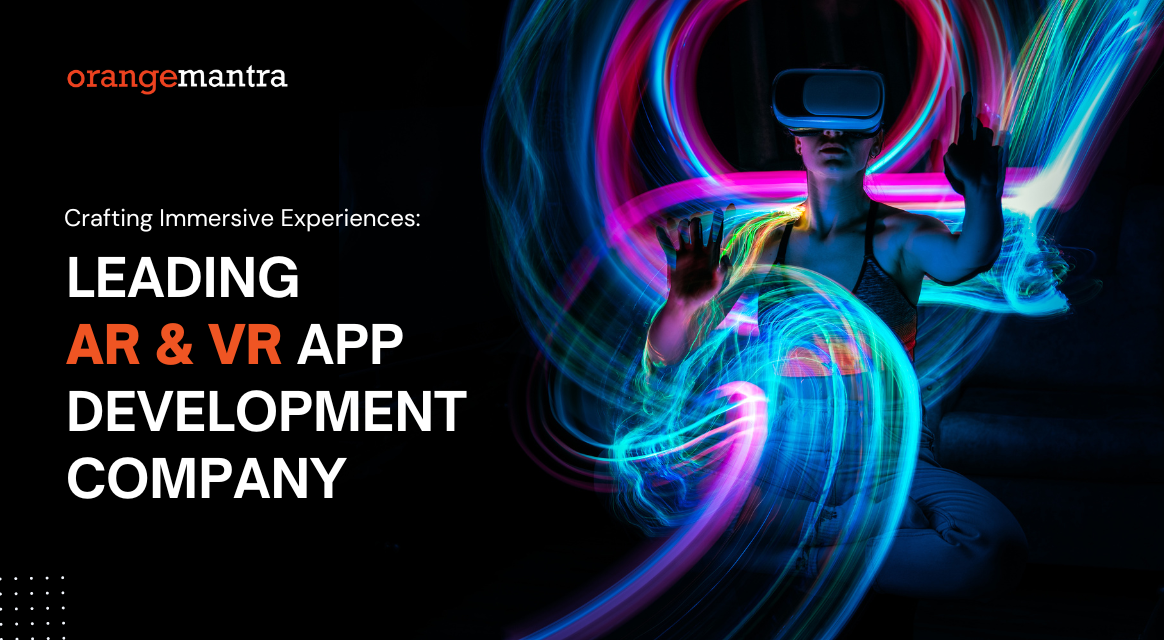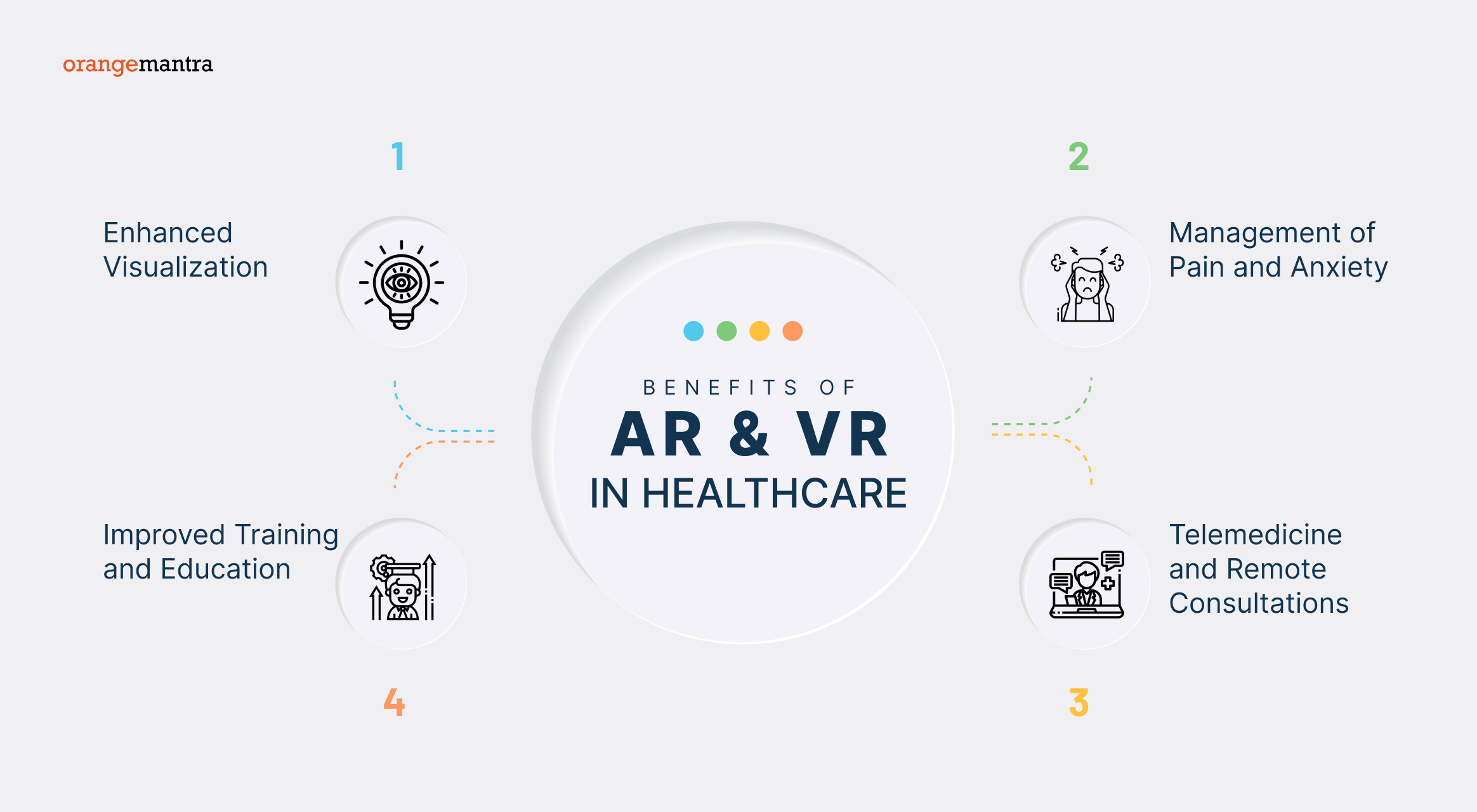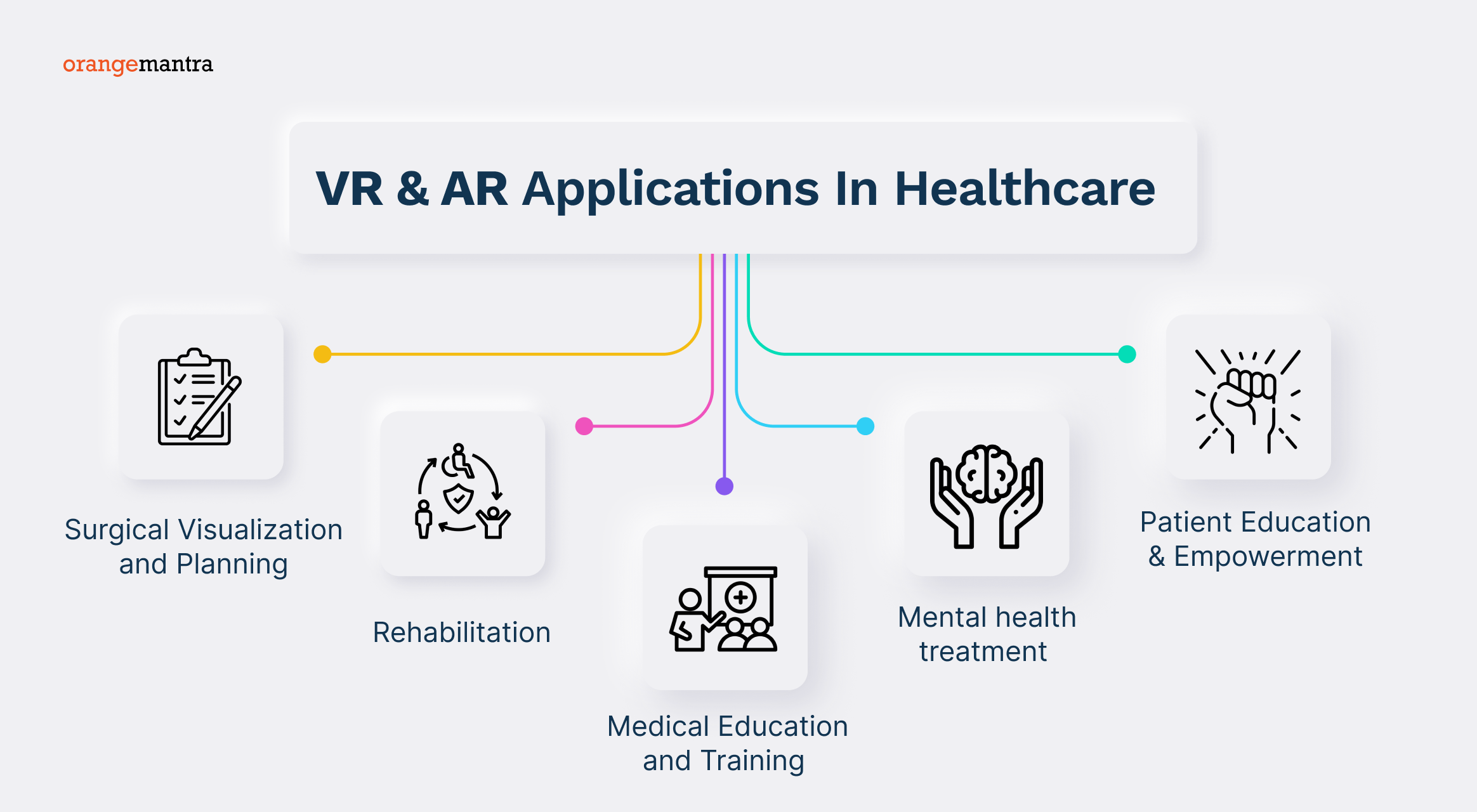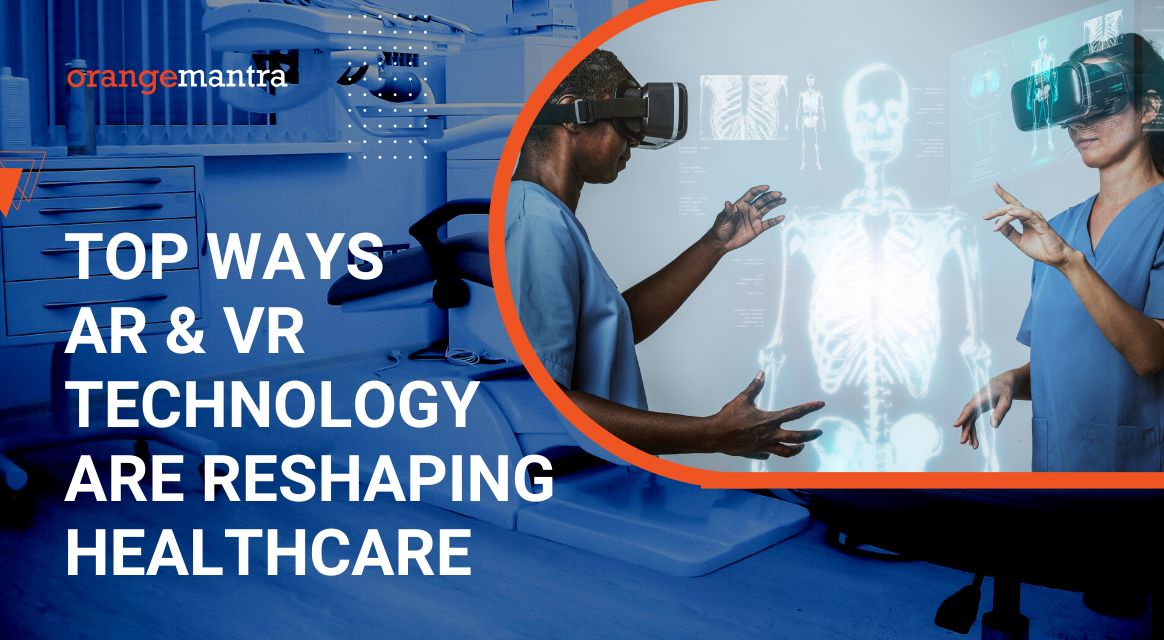
Here’s what you will learn:
Technology has transformed many businesses in today’s fast-paced, constantly evolving world, and the healthcare industry is no different. The future of healthcare is experiencing seismic change because of ground-breaking advancements like Augmented Reality (AR) and Virtual Reality (VR). In this blog, we will understand how AR app development and VR app development companies can help businesses and healthcare professionals in their respective fields.
Table of Contents
What does the term “AR and VR technology” mean?
The integration of digital data, such as pictures, sounds, or 3D models, into the user’s actual surroundings, is known as AR. AR app development company improves the user’s view of and engagement with their environment by superimposing computer-generated material over the real world. Through the seamless blending of the real and the virtual, this technology enables healthcare providers to provide dynamic and immersive experiences to both patients and medical personnel.
VR technology, on the other hand, submerges users in a wholly virtual environment, cutting them off from the real world. VR headsets and motion sensors give users the compelling impression that they are in a completely new location. Medical professionals may teach, diagnose, and treat patients with unparalleled accuracy and efficacy because of the VR app development company.
How the Future of Healthcare is Being Reshaped by AR and VR?
The use of AR and VR technology in healthcare is revolutionizing the field and reshaping patient care, medical education, and the patient experience as a whole.
By considerably increasing the precision and effectiveness of diagnosis, augmented reality and virtual reality are set to revolutionize patient care. Medical practitioners may now use augmented reality to interactively and physically visualize complicated medical data, such as CT scans or MRI pictures.
Doctors may spot irregularities, arrange procedures, and discuss treatment choices with greater accuracy and assurance if they are well familiar with a patient’s anatomy. Contrarily, VR allows patients to experience therapeutic settings that lessen pain, lessen anxiety, and improve general well-being.
These virtual worlds may help patients get through painful medical procedures and possibly speed up the recovery process. Moreover, by giving prospective medical professionals priceless chances for hands-on learning, AR and VR technologies play a key role in medical education.
Healthcare AR and VR Evolution
The development of augmented reality and virtual reality in healthcare has been characterized by notable developments and extensive acceptance in several medical specialties. Here are some amazing numbers and data that highlight the astonishing development of these technologies:
According to a Grand View Research analysis, the worldwide market for AR and VR in healthcare is predicted to reach an astounding $11.14 billion by 2025.
According to Goldman Sachs research, the healthcare sector would be the one that adopts VR at the fastest rate, with a predicted investment of $5.1 billion by 2025.
It has been shown that the use of VR-based simulations enhances surgical results and lowers the risk of complications during difficult operations.
Benefits of AR and VR in Healthcare
The use of AR and VR technologies in healthcare has several advantages that improve patient care and medical procedures on the whole. Let’s examine a few of the main benefits:
-
Enhanced Visualization:
AR and VR app development companies make it possible for medical personnel to interactively and fully immerse themselves in complicated medical data, anatomical structures, and patient-specific information. Accurate diagnostics, surgical planning, and patient education are all facilitated by this improved visualization.
-
Improved Training and Education:
AR app development and VR app development companies provide healthcare professionals and students with immersive and realistic training environments that enable hands-on practice in a secure environment. This hands-on education improves abilities, memory of information, and confidence, which eventually leads to better patient outcomes.
-
Management of Pain and Anxiety:
Advantages of virtual reality technology enable the construction of calming and immersive virtual worlds that help lower patients’ perceptions of Pain and Anxiety. VR assists in pain management during medical operations and improves the overall patient experience by providing diversion and encouraging relaxation.
-
Telemedicine and Remote Consultations:
With the use of AR app development company and VR app development company, healthcare professionals can conduct remote consultations, provide knowledgeable counsel, and give instructions regardless of geographic limitations. Advantages of augmented reality technology make effective telemedicine practices possible, enhancing access to healthcare in off-the-grid locations and in times of crisis.
VR and AR applications in healthcare
The use of augmented reality and virtual reality in healthcare is extensive and growing. These are some of the main areas in which these technologies are having a big impact:
-
Surgical Visualization and Planning
AR and VR let doctors precisely see the anatomical features unique to each patient, direct surgical operations, and enhance overall surgical results.
-
Rehabilitation
VR may be used to build therapeutic, immersive settings that help people with pain management and psychological and physical rehabilitation.
-
Medical Education and Training
For medical students and professionals, AR and VR technologies provide lifelike and interactive simulations that promote skill development and information retention.
-
Mental health treatment
VR-based settings provide exposure therapy patients with a secure and monitored environment, enabling therapists to successfully treat patients with anxiety disorders, phobias, and PTSD.
-
Patient Education and Empowerment:
Using AR and VR technologies, people may more easily and effectively visualize their health issues, treatment options, and prospective outcomes, which improves patient education.
Some Top ways in which AR and VR technology can reshape the healthcare sector
-
Medical Learning Instruction and Facilitation
Medical education and training are being revolutionized by AR and VR technology. They provide realistic and interactive experiences that let medical practitioners practice different techniques and situations in a secure setting. With AR, medical professionals may superimpose digital data onto actual things to better grasp intricate anatomical systems. On the other side, VR allows students to practice medical procedures and operations without endangering actual patients.
-
Developing skills via training
The prospects for skill development in healthcare provided by AR and VR are excellent. Medical personnel may improve patient outcomes, hone their decision-making skills, and perfect their practices via realistic simulations.
Through the use of these technologies, professionals may simulate difficult situations and build confidence and knowledge in pressing circumstances. AR and VR provide a realistic teaching environment that connects theory and practice for anything from operations to medical crises.
-
Body mapping or online help
The capacity of AR and VR to map the human body has made it possible to provide virtual medical help. Doctors may see and assess patient medical issues in real time by superimposing digital data over the patient’s body.
This aids in precise patient monitoring, therapy planning, and diagnosis. Additionally, benefits of augmented reality and VR can direct surgeons during difficult operations, giving them crucial information and lowering the margin of error. These technologies’ accuracy and efficiency raise the standard of healthcare as a whole.
-
Realistic 3D imaging or augmented surgery
The world of medicine has transformed because of AR app development companies and VR app development companies in surgical operations. Surgeons may see patient anatomy with augmented overlays by using AR glasses or utilizing VR headsets, which produce a lifelike 3D visualization of the operating area.
This leads to increased surgical planning, more accuracy, and fewer problems. Furthermore, AR and VR allow for the cooperation of surgeons, enabling them to digitally share their knowledge and provide remote support, even in difficult instances.
-
Representing real-world medical training
For safe and regulated environments for actual medical teaching, AR and VR simulations are available. To hone their clinical abilities, medical students and residents may participate in realistic exercises like bedside evaluations or emergency response simulations. These simulations help students develop their competence and be ready for actual patient interactions by empowering them to make decisive judgments under duress.
-
Better patient care and education
The potential of AR and VR for patient education and bettering healthcare outcomes is enormous. Patients may get a better understanding of their medical issues, procedures, and available treatments via immersive experiences.
This gives people the ability to decide for themselves and take an active role in their healthcare. Additionally, AR and VR technologies may help medical professionals communicate intricate medical information in a more approachable and captivating way, enhancing patient understanding and treatment plan adherence.
-
Correct illness and risk diagnosis
Advanced diagnostic tools are available to healthcare practitioners because of AR and VR technology. Doctors can see and analyze complicated medical pictures, such as CT scans and MRIs, more precisely and logically by merging patient data with virtual reality.
They can detect illnesses precisely and recognize minor anomalies as a result, leading to early treatments and better patient outcomes. Diagnostic medicine is undergoing a revolution because of the improved visualization and interpretation capabilities provided by AR and VR.
-
Telemedicine’s capabilities
The possibilities of telemedicine are being expanded significantly because of AR app development companies and VR app development companies. Healthcare professionals may remotely evaluate patients, provide advice, and even carry out certain treatments thanks to immersive technology. Patients may electronically consult professionals without having to physically travel, giving them access to high-quality healthcare no matter where they are in the world.
AR and VR’s effects on healthcare
The use of AR and VR in healthcare has a significant influence. These innovations are revolutionizing patient care, increasing surgical techniques, advancing diagnostic accuracy, and redefining medical education. AR and VR enable healthcare workers to improve their abilities and make more informed choices by offering immersive experiences.
Patients gain from more involvement, comprehension, and accessibility to specialized treatment. Future healthcare will change as AR and VR develop further. And are integrated, resulting in better results and a more effective healthcare system.
Wrapping Up!
AR app development and VR app development companies are remarkably changing the landscape of healthcare. These immersive Artificial Intelligence Solutions Technologies have limitless potential, with applications ranging from boosting surgical accuracy and pain management to revolutionizing patient care and advancing medical education. We can anticipate a day when individualized, effective, and patient-centered healthcare becomes the new standard as the healthcare sector continues to adopt AR and VR.
FAQ
-
In which sectors are AR and VR apps used?
Numerous businesses, including gaming, real estate, healthcare, education, entertainment, tourism, training, and manufacturing, can benefit from AR and VR apps.
-
How much expertise does your team have in developing AR and VR?
Our team is made up of very talented engineers, designers, and specialists with a wealth of knowledge in AR and VR. We have completed several projects, demonstrating our expertise in developing unique and captivating AR and VR experiences.
-
What distinguishes VR from augmented reality?
AR enhances a user’s perspective of their surroundings by adding virtual features to the actual environment. Users may engage with a completely realistic digital world created by, often utilizing a VR headset.
-
For what operating systems do you create AR and VR apps?
We create AR and VR applications for many different operating systems, including iOS, Android, Windows, and web-based software. Our development team makes sure that all devices work together and function at their best.
-
How much time does it take to create an AR or VR app?
The length of time it takes to build a project depends on its complexity, the features it needs, and the specifics of its design. During the preliminary consultation stage, we provide a comprehensive project schedule.
-
What technologies do you use while developing AR and VR applications?
We use state-of-the-art tools like Unity3D, Unreal Engine, ARCore, ARKit, Vuforia, and others to build immersive AR and VR experiences that adhere to the highest standards set by the sector.





